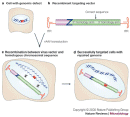You may find it hard to imagine that something as simple as a single base change—specifically, the appearance of a cytosine instead of a thymine somewhere along the 3-trillion-base-long human genome—could lead to a condition as profound as blindness. Yet, in certain cases of congenital blindness known as Leber congenital amaurosis, this is exactly what happens. On first glance, it seems tantalizingly simple to fix disorders that are caused by mutations in a single gene: Simply insert the correct form of the mutant gene into the cells that need the functioning gene, then stand back and watch the disease disappear. However, the field of gene therapy, in which scientists work to treat disorders at the level of the sequence of mutated genes, is much more complicated than it first appears.
How to Get Therapeutic DNA Inside Cells
One major obstacle facing effective gene therapy involves finding the best way to deliver therapeutic genes into target cells within the body. Scientists have tested a number of methods, some of which utilize liposomes or cell surface receptors. But the most common method of DNA delivery employs something that is perfectly evolved to enter cells: the virus.
Viruses are obligate intracellular parasites, designed through the course of evolution to infect cells, often with great specificity to particular cell types. Viruses efficiently transfect their own DNA into a host cell, then use the host's cellular machinery to replicate their DNA and synthesize certain viral proteins, thereby producing more viral particles. When it comes to gene therapy, scientists can capitalize on this process by removing the disease-causing portions of the viral genome and adding a foreign therapeutic gene. The engineered genome is then repackaged into the viral protein coat and allowed to infect the proper cell target. Now, instead of producing viral toxins and causing disease, the cell infected by this virus is able to produce the protein or enzyme it lacks.
One of the more common ways of introducing the wild-type version of a gene into cells with a defective copy is by way of an adenovirus. It is possible to use recombinant DNA technology to introduce a wild-type gene into an adenoviral vector. Once the adenovirus has infected the target cells, homologous recombination can occur, resulting in replacement of the native, mutant copy of the gene with the wild-type version from the vector (Figure 1).








 Figure 1
Figure 1








